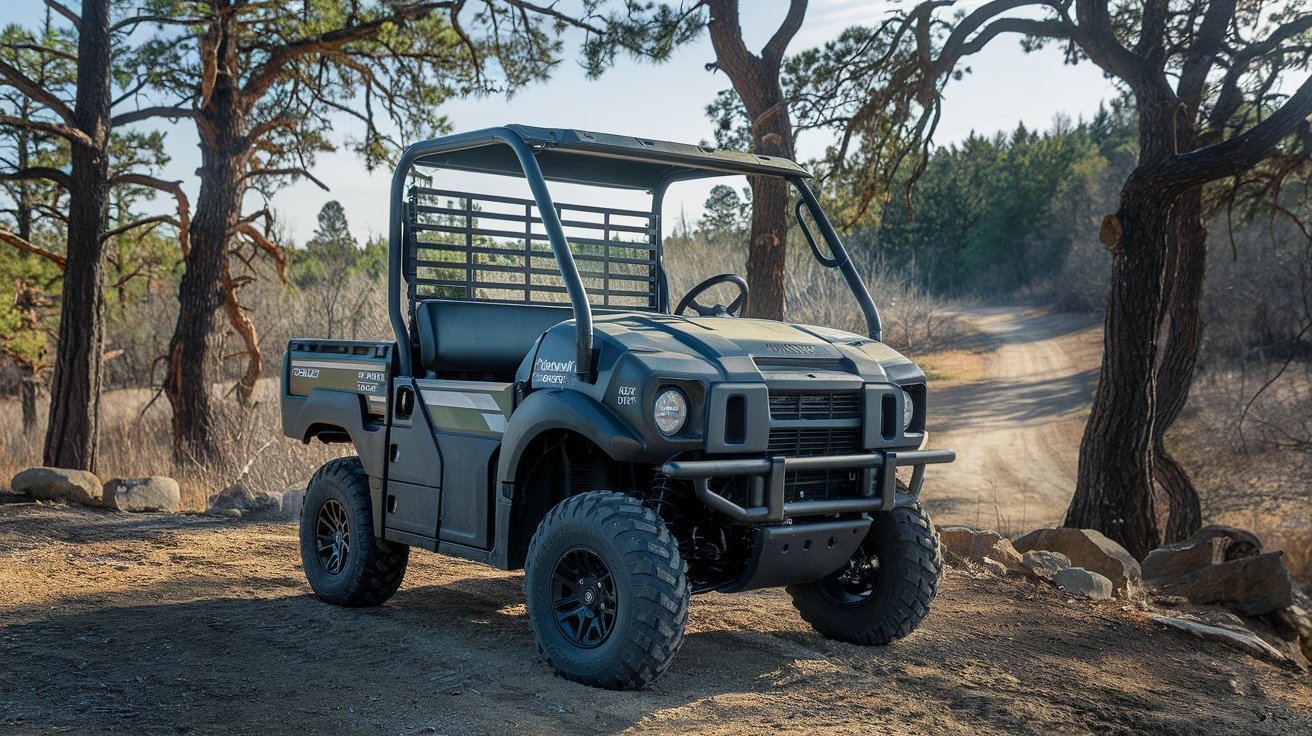Power loss in your Kawasaki Mule 4010 DFI is often caused by a clogged air filter, dirty fuel injectors, or throttle body issues. Regular maintenance, such as cleaning or replacing these components, can restore performance and prevent further problems.
Want to dive deeper? Learn about the top 10 Kawasaki Mule 4010 DFI problems and how to solve them effectively to keep your Mule running like new. Check out our full guide!
This guide explores the top 10 Kawasaki Mule 4010 DFI problems and provides practical solutions to help you keep your vehicle running smoothly.
1. Starting Issues
One of the most common Kawasaki Mule 4010 DFI problems is difficulty starting the engine, especially in colder climates or after prolonged periods of inactivity.
Causes:
- Weak or dead battery.
- Faulty spark plugs.
- Fuel delivery issues.
Solutions:
- Check the Battery: Use a multimeter to test the battery’s voltage. If it reads below 12.6 volts, recharge or replace it.
- Inspect Spark Plugs: Remove and examine the spark plugs for wear or fouling. Replace them if necessary.
- Fuel System Maintenance: Ensure the fuel lines are clear and the fuel pump is functioning correctly. Use fresh, clean fuel to avoid clogs.
2. Overheating Engine
An overheating engine can hinder performance and cause long-term damage if not addressed promptly.
Causes:
- Low coolant levels.
- Faulty thermostat.
- Blocked radiator.
Solutions:
- Check Coolant Levels: Regularly monitor and top off the coolant reservoir.
- Inspect the Thermostat: Replace the thermostat if it’s stuck closed.
- Clean the Radiator: Remove debris from the radiator fins and ensure proper airflow.
3. Transmission Problems
Transmission issues, such as difficulty shifting or unusual noises, can affect the vehicle’s drivability.
Causes:
- Low transmission fluid.
- Worn or damaged gears.
- Misaligned linkage.
Solutions:
- Monitor Fluid Levels: Check and top up the transmission fluid as needed.
- Inspect Components: Examine the gears and linkage for wear or damage, and replace them if necessary.
- Lubricate Moving Parts: Proper lubrication can improve shifting performance.
4. Poor Acceleration
A lack of power during acceleration is another frequent complaint from Kawasaki Mule 4010 DFI owners.
Causes:
- Clogged air filter.
- Fuel injector problems.
- Throttle body issues.
Solutions:
- Replace the Air Filter: A clean air filter ensures proper airflow to the engine.
- Clean the Fuel Injectors: Use a fuel injector cleaner or have them professionally serviced.
- Inspect the Throttle Body: Clean the throttle body to ensure smooth operation.
5. Electrical System Failures
Electrical problems can range from non-functional lights to a complete lack of power.
Causes:
- Corroded wiring.
- Blown fuses.
- Malfunctioning alternator.
Solutions:
- Inspect Wiring: Look for signs of corrosion or damage and repair as needed.
- Replace Fuses: Check the fuse box and replace blown fuses.
- Test the Alternator: Use a multimeter to ensure the alternator is charging the battery correctly. Replace it if faulty.
6. Brake Issues
Brakes are critical for safety, and any issues should be addressed immediately.
Causes:
- Worn brake pads.
- Leaking brake fluid.
- Misaligned brake components.
Solutions:
- Replace Brake Pads: Check the thickness of the brake pads and replace them if they’re worn.
- Check for Leaks: Inspect the brake lines and master cylinder for leaks. Refill and bleed the brake fluid if necessary.
- Align Components: Adjust and align the brake system to ensure optimal performance.
7. Steering Difficulties
Stiff or unresponsive steering can make maneuvering the Mule 4010 DFI challenging.
Causes:
- Low power steering fluid.
- Damaged steering linkage.
- Worn steering rack.
Solutions:
- Top Off Power Steering Fluid: Ensure the reservoir is filled to the recommended level.
- Inspect the Linkage: Look for damage or wear in the steering components and replace them if needed.
- Check the Steering Rack: Repair or replace the steering rack if it’s causing stiffness.
8. Suspension Problems
A rough ride or uneven suspension can indicate underlying issues with the suspension system.
Causes:
- Worn-out shocks or struts.
- Broken springs.
- Loose suspension components.
Solutions:
- Replace Shocks and Struts: Install new ones if the ride quality has deteriorated.
- Inspect Springs: Look for cracks or breaks and replace faulty springs.
- Tighten Components: Check all bolts and nuts in the suspension system and tighten them to the manufacturer’s specifications.
9. Fuel Efficiency Decline
A noticeable drop in fuel efficiency can lead to higher operating costs.
Causes:
- Dirty air filter.
- Faulty oxygen sensor.
- Improper tire pressure.
Solutions:
- Maintain the Air Filter: Regularly clean or replace the air filter.
- Replace the Oxygen Sensor: A malfunctioning oxygen sensor can affect the fuel-to-air ratio.
- Check Tire Pressure: Inflate the tires to the recommended PSI to improve fuel economy.
10. Rust and Corrosion
Rust and corrosion can compromise the structural integrity of the vehicle and its components.
Causes:
- Exposure to moisture and salt.
- Lack of proper cleaning.
Solutions:
- Wash Regularly: Clean the vehicle after use, especially in wet or salty conditions.
- Apply Anti-Rust Treatments: Use rust inhibitors or protective coatings on vulnerable areas.
- Inspect and Repair: Address any rust spots immediately to prevent them from spreading.
Proactive Maintenance Tips
To avoid these common Kawasaki Mule 4010 DFI problems, follow these proactive maintenance practices:
- Regular Inspections: Perform routine checks on all systems and components.
- Follow the Owner’s Manual: Adhere to the manufacturer’s maintenance schedule.
- Use Quality Parts: Always use genuine Kawasaki parts and high-quality fluids.
- Store Properly: Keep the vehicle in a dry, sheltered area when not in use.
Frequently Asked Questions (FAQs)
1. How often should I service my Kawasaki Mule 4010 DFI?
Regular servicing should be done every 50 hours of operation or as specified in the owner’s manual. Major maintenance tasks, like changing transmission fluid or checking the valve clearance, are typically recommended every 200 hours.
2. Why is my Kawasaki Mule 4010 DFI losing power?
Loss of power could be due to a clogged air filter, dirty fuel injectors, or an issue with the throttle body. Cleaning or replacing these components often resolves the issue.
3. What type of oil is best for the Kawasaki Mule 4010 DFI?
Use high-quality 10W-40 motor oil designed for ATVs or utility vehicles. Always refer to the owner’s manual for specific recommendations.
4. How do I troubleshoot electrical problems in my Kawasaki Mule 4010 DFI?
Start by checking the battery, fuses, and wiring connections for any signs of damage or corrosion. If the problem persists, test the alternator and key electrical components.
5. Can I use my Kawasaki Mule 4010 DFI in winter conditions?
Yes, but it’s important to use the appropriate oil and coolant for cold weather. Regularly inspect the battery and fuel system to ensure reliable starting in low temperatures.
6. What should I do if my Mule 4010 overheats?
Stop using the vehicle immediately and let the engine cool down. Check the coolant levels, radiator, and thermostat for any issues. Resolve the problem before resuming use to prevent further damage.
Final Thoughts
Understanding and addressing these common Kawasaki Mule 4010 DFI problems can save you time, money, and frustration. By maintaining your vehicle and addressing issues promptly, you can extend its lifespan and ensure optimal performance.
Have you experienced any other issues with your Kawasaki Mule 4010 DFI? Share your feedback and tips in the comments below!

